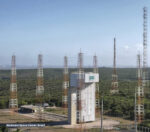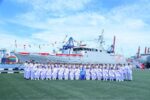Italian shipbuilding giant Fincantieri has unveiled “DEEP” (Deployable Expeditionary Ecosystem Platform), its first fully integrated modular underwater drone system. Designed to enhance undersea situational awareness and support a range of military and dual-use missions, DEEP marks a significant milestone in Italy’s push toward autonomous maritime systems. The unveiling took place during the SEAFUTURE 2023 exhibition in La Spezia.
DEEP: An Integrated Ecosystem for Underwater Autonomy
DEEP is not just a single vehicle but a modular ecosystem composed of multiple unmanned underwater vehicles (UUVs), launch and recovery systems (LARS), mission control infrastructure, and interoperable payloads. The architecture is designed to support both military and civilian applications including mine countermeasures (MCM), intelligence-surveillance-reconnaissance (ISR), anti-submarine warfare (ASW) support, subsea infrastructure inspection, seabed mapping, and environmental monitoring.
The system is scalable across three operational configurations:
- Containerized Module: A self-contained deployable unit with power supply and control interfaces suitable for rapid deployment from shore or vessels of opportunity.
- Embarked Module: Designed for integration aboard naval platforms such as offshore patrol vessels (OPVs) or auxiliary ships.
- Permanent Installation: For fixed coastal surveillance or critical infrastructure protection roles.
This flexibility allows DEEP to be tailored to mission needs ranging from expeditionary deployments to persistent surveillance in contested littoral zones.
Technical Capabilities and Payload Integration
The core of the DEEP system includes multiple classes of UUVs—likely ranging from man-portable lightweight drones to larger mid-size autonomous vehicles—though Fincantieri has not disclosed detailed specifications such as endurance or depth rating. However, based on comparable European systems like Saab’s AUV62 or ECA Group’s A18-M family, it is reasonable to expect endurance in the 10–20 hour range with operational depths exceeding 300 meters depending on configuration.
The UUVs are designed with open architecture principles allowing integration of various sensor suites including:
- Synthetic aperture sonar (SAS) for high-resolution seabed imaging
- Side-scan sonar (SSS) for mine detection
- Environmental sensors for salinity/temperature profiling
- Cameras and laser scanners for visual inspection tasks
The system also supports secure communications via acoustic modems and potentially through-tethered links when used in shallow water. Command-and-control is managed via an advanced mission planning suite that enables pre-programmed autonomy or real-time operator input depending on mission complexity.
Tactical Applications Across Naval Domains
The modularity of DEEP makes it suitable across a spectrum of naval operations. In military contexts, it can be deployed ahead of amphibious landings to clear mines or map seabed topography. It can also augment ASW operations by acting as an active/passive sonar node within distributed sensor networks—especially relevant given NATO interest in distributed maritime ISR architectures.
Civilian applications include port security inspections, pipeline monitoring in the energy sector, environmental surveys post-natural disasters, and supporting search-and-rescue missions through sonar-based object detection. The dual-use nature aligns with Italy’s broader defense-industrial strategy emphasizing civil-military synergies under EU-funded programs such as EDF (European Defence Fund).
A Strategic Move Toward Sovereign Underwater Capability
The development of DEEP reflects Italy’s ambition to establish sovereign capabilities in the growing field of unmanned maritime systems—a domain traditionally dominated by U.S., UK, French, and Scandinavian OEMs. Fincantieri’s move comes amid increasing NATO focus on undersea domain awareness due to rising submarine activity by Russia in the Mediterranean and North Atlantic theaters.
This project also complements recent Italian Navy modernization efforts which include new multipurpose OPVs designed with modular mission bays suitable for hosting UUV/USV systems. By integrating DEEP into these future vessels—such as those under the PPA-class program—Italy could significantly enhance its expeditionary MCM and ISR reach without deploying crewed assets into high-risk zones.
Industrial Collaboration and Export Potential
While developed primarily by Fincantieri NextTech—a subsidiary focused on innovation—the DEEP program reportedly involves collaboration with Italian defense electronics firm Leonardo for sensor integration and possibly acoustic communication modules. There may also be synergies with NATO’s MUSIS program (Maritime Unmanned Systems Initiative) where interoperability across allied fleets is a key objective.
The export potential is notable given growing global demand for cost-effective undersea surveillance tools among navies lacking nuclear submarine fleets but facing asymmetric threats like sea mines or underwater sabotage against critical infrastructure such as gas pipelines—as seen during recent Baltic Sea incidents involving Nord Stream pipelines.
Outlook: From Prototype to Operational Deployment?
No timeline has been officially announced regarding full operational capability or procurement by the Italian Navy. However, demonstration trials are expected throughout late 2024 into early 2025 based on industry sources familiar with SEAFUTURE announcements. If successful—and competitively priced—DEEP could position Fincantieri as a credible player in Europe’s rapidly evolving unmanned maritime systems market alongside Thales/ECA Group (France), Kongsberg Maritime (Norway), Saab Dynamics (Sweden), and L3Harris Technologies (USA).
This development reinforces trends toward multi-domain integration where surface ships act as motherships deploying layered autonomous assets across air/surface/subsurface domains—a concept central to NATO’s Future Naval Force Structure doctrine currently under review post-Ukraine war lessons learned.









